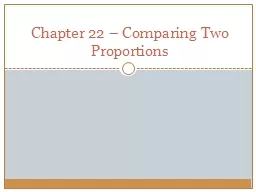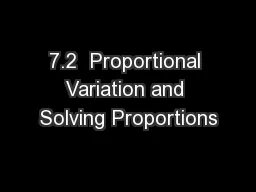PPT-Chapter 22 – Comparing Two Proportions
Author : phoebe-click | Published Date : 2018-03-15
Difference Between Proportions Sometimes we want to see if there is a significant difference between independent groups Control group vs treatment group or placebo
Presentation Embed Code
Download Presentation
Download Presentation The PPT/PDF document "Chapter 22 – Comparing Two Proportions" is the property of its rightful owner. Permission is granted to download and print the materials on this website for personal, non-commercial use only, and to display it on your personal computer provided you do not modify the materials and that you retain all copyright notices contained in the materials. By downloading content from our website, you accept the terms of this agreement.
Chapter 22 – Comparing Two Proportions: Transcript
Download Rules Of Document
"Chapter 22 – Comparing Two Proportions"The content belongs to its owner. You may download and print it for personal use, without modification, and keep all copyright notices. By downloading, you agree to these terms.
Related Documents














